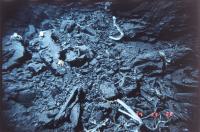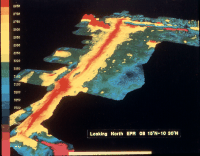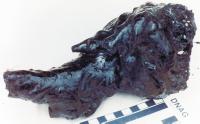Submarine Solutions
UF geologists probe the ocean floors for clues to how the Earth developed
by Lurel D. Ponjuan
Geologic phenomena have always fascinated humans. In ancient times, people attributed many of the mysteries of nature to the mytho- logical gods. Volcanic eruptions in Sicily were ascribed to the Roman fire god Vulcan, and tidal waves were Poseidon's anger unleashed.
And while geology as a science advanced dramatically over the centuries, for all geologists knew about the 70 percent of the Earth's surface that is covered by oceans, what happened beneath the waves might as well have been the work of gods.
But through the application of modern technology, geologists at the University of Florida and elsewhere now are able to base their theories about the role the ocean floor plays in the Earth's development on fact rather than fantasy. Poseidon has begun to reveal his secrets.
This oceanographic focus is just one element of a geology department at UF that is coming into its prime. With $1 million from the National Science Foundation and another $2 million from the state, the department will celebrate its 50th anniversary in 1998 by moving into 17,000 square feet of renovated space in Williamson Hall, formerly occupied by the physics department.
Bolstered by this major grant, the attraction of talented faculty and a commitment to providing them with the best equipment, the department expects to remain a leader in Earth sciences and to continue its broad-based research into geologic phenomena, Chairman Paul Mueller says.
``Our department made an early commitment to this technological revolution by developing state-of-the-art analytical and experimental laboratories that enable us to pursue a wide spectrum of research, from deciphering the origin of continents and oceans to investigating the history of global climate and life and determining the best geologic materials for highway construction,'' he says.
The following profiles highlight the research of three UF geology faculty whose research is focused on the Earth's past, present and future by looking beneath the waves.
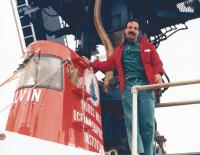
UF geology Professor Michael Perfit boarding the ALVIN submersible. |
Right Place, Right Time
Mike Perfit had been observing dormant volcanoes on the ocean floor for a decade when he and two colleagues climbed into the ALVIN submersible in 1991 for what had become a routine 8,000-foot descent to the sea floor, 500 miles due west of Costa Rica.
His destination was the East Pacific Rise, one of a series of volcanic mountain ranges that stretches for 40,000 miles around the Earth like the seams on a baseball. The underwater mountains along the crest are about a mile high and a couple of miles across.
``Soon, the tiny observation ports were covered with water, bubbles and seafoam, and I could see the crew's divers releasing us from the grasp of the mother ship, Atlantis II,'' Perfit recalls of a trip he has now made 35 times.
The 2-hour trip to the ocean floor was made longer by cramped conditions and cold temperatures aboard the tiny research sub, which measures just 23 feet long by 12 feet high by 7.5 feet wide.
But as the sub neared the sea floor and the pilot turned on high-intensity
lights to illuminate the rocky, volcanic terrain, the scientists aboard ALVIN
saw something totally unexpected.
|
photos from Woods Hole Oceanographic Institute  UF geology Professor Michael Perfit aboard the ALVIN submersible;
|
``Something was clearly different --- the water was filled with fragments of a white cotton-like material flowing past ALVIN's portholes and recording cameras,'' Perfit says. ``It looked like an inverted snowstorm and we couldn't seem to drive out of it.
That ``snowstorm'' turned out to be ``mats'' of bacteria that thrive in the very hot (700 degrees), sulfur-rich environment being blown up into the water.
``As we got closer to the sea floor we noticed that the normally jet-black lava flows were covered with this same cotton-like material. We were having trouble recognizing the area we had so carefully mapped only a few years before. Then we noticed something truly remarkable: tubeworms encased in shiny black lava flow. The only way these scorched and barely living deep-sea creatures could be like this was if an eruption was in progress.''
Perfit and his colleagues dubbed this phenomenon the ``Tubeworm Barbeque,'' an area where thousands of newly killed tubeworms and a few survivors lay buried beneath a thin layer of new lava. The event was so recent that crabs and other scavengers had only recently arrived to eat the dead tubeworms.
``There was hot water coming from every facet of the rift zone on the ridge,'' he says. ``There were bacteria --- the most primitive form of life --- in every nook and cranny.''
Although scientists had studied the effects of eruptions along ridges, no one had ever observed an actual eruption. Now Perfit was seeing a ridge erupt inches from his face.
``Although we know that oceanic ridges are the most volcanically active sites on Earth, no one had ever seen one actively erupting,'' he says. ``I was one of the lucky ones, and for me it was a dream come true.''
The 1991 East Pacific Rise eruption, and another scientists observed in 1993 along the Juan de Fuca Ridge off the coast of Washington, gives geologists like Perfit an opportunity to study the development of a ridge crest and the crustal construction caused by volcanism, a project the National Science Foundation funds.
``We're looking at the similarities and the differences between the two eruptions to see what happens as the oceanic ridge is constructed and as life continues to evolve in these centers,'' Perfit says.
The implications from these ``lucky'' encounters proved to be extremely valuable not just for geologists --- in terms of how heat from the eruptions affects the Earth's climate and what role the eruptions play in continental movement --- but for biologists as well.
``Biologists used to think it would take decades for life to find its niches and to grow,'' he says. ``What we found is that it can take place on a yearly basis. You can see life change and grow and develop literally within months to a year of an eruption. All the time frames are much faster than we expected.''
When the scientists' findings were published in the journal Nature in October 1994, Robert Corell of the NSF told The New York Times they were ``one of the most dramatic underwater discoveries in history.''
``These findings dramatically alter our views of the rates at which biological and geological processes are occurring in a variety of environments on Earth, particularly in the deep sea,'' Corell told the newspaper.
Observing these eruptions also has given scientists greater insight into how and where minerals are deposited.
``There are a number of very rich mineral deposits of mostly copper, zinc and iron that are created at the ridge crests,'' Perfit says. ``The land deposits are mostly old sea-floor deposits so if you understand how and where they form in the oceans, you can go to areas on land that used to be oceans to find the deposits.''
The fact that numerous scientific disciplines benefit from this research is not unusual but is instead a common result of geologic research, says Perfit. Geology naturally incorporates many sciences and is both enhanced by, and enhances, other fields.
``This is definitely a multi-disciplinary approach. Myself and my
colleagues --- who are at a number of different institutions in the United
States --- have been working in a synergistic way,'' Perfit says.
``We're trying to figure out how geology and volcanology relate to the
chemistry of water, how water chemistry relates to biology and how water
affects the rocks. It's been a great way to use all of the disciplines,
which I think is one of the most important aspects of geology --- it
integrates everything from physics to chemistry to biology.''
|
photos from University of Miami / NOAA  Ellen Martin, assistant professor of geology; |
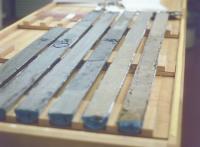 sediment cores from which prehistoric fish teeth are extracted for analysis;  |
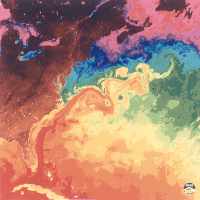 satellite view of the western Atlantic Ocean, showing the warmer waters of the Gulf Stream in oranges and reds. |
Fish Teeth And The Future
Global warming, or the ``greenhouse effect'' produced by elevated levels of carbon dioxide (CO2) in the atmosphere, has received considerable attention in recent years.
UF geology assistant Professor Ellen Martin uses elements in microscopic prehistoric fish teeth to learn more about the Earth's past climate and what it can tell us about the future.
Geologists know the Earth has undergone similar periods of increased CO2 levels in the past, and Martin hopes a better understanding of those periods will help scientists predict the impact of current global warming patterns.
By recording the depth and isotopic composition of a unique element called neodymium that is present in fish teeth recovered from deep-sea sediments drilled from the floor of the Atlantic Ocean, Martin hopes to build a model of prehistoric ocean circulation.
``Understanding how the ocean circulated in the past can tell us a lot about the climate because the ocean helps redistribute heat,'' Martin says. ``In addition, the ocean is one of the largest reservoirs of CO2 on Earth. Therefore, there likely is a link between changes in ocean circulation and levels of atmospheric CO2.''
There are times in the past when the Earth was much warmer than present and times when it was much cooler, Martin says.
``The question is: Were those climatic changes a result of variations in the level of CO2 in the atmosphere or changes in the transportation of heat from the equator to the poles by the ocean, or some combination of the two?''
Today, the warm Gulf Stream waters flow north to an area near Greenland where they cool and sink into the deep ocean. The heat released from the water by this process is transferred to the atmosphere and transported over northern Europe, where it helps keep that region unusually warm for its latitude. During the last glacial period, this circulation system slowed down, a change that appears to be associated with a decrease in the CO2 level in the atmosphere.
Martin's research on ocean circulation patterns and the links between ocean circulation and atmospheric CO2 is funded by a five-year, $300,000 Faculty Early Career Development Program grant from the National Science Foundation.
``Everybody agrees that the amount of CO2 in the atmosphere is
increasing,'' she says. ``The big question is: How will the Earth
system respond and what are the effects going to be?''
Continental Drift
When Neil Opdyke first began his research in the early 1960s, the concept of an Earth where you could walk from Florida to Africa, of ``supercontinents'' like Pangaea and Godwanaland and Laurasia, was still the subject of much scientific debate.
photo by Ray Carson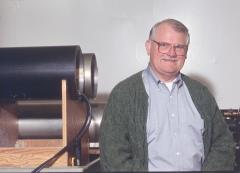
|
| Geology Professor Neil Opdyke, a member of the National Academy of Sciences, helped prove that the continents were once assembled into two great land masses (top map) before ``drifting'' apart into their current configuration (bottom map). |
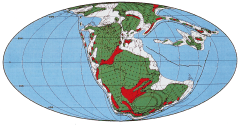 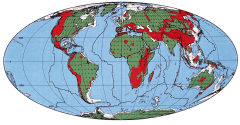
|
As late as 1963 --- when Opdyke was beginning his research at Columbia University's Lamont-Doherty Geological Observatory in Palisades, N.Y. --- an article in Scientific American reported that opinions on the theory of continental drift ``divide most sharply between the position that the Earth has been rigid throughout its history ... and the opinion that the Earth is slightly plastic, with the continents slowly drifting over its surface, fracturing and reuniting and perhaps growing in the process.''
Five years later, another article in Scientific American that cited Opdyke's research was titled ``The Confirmation of Continental Drift'' and subtitled ``After years of debate many lines of evidence now favor the idea that the present continents were once assembled into two great land masses: Godwanaland in the south, Laurasia in the north.''
Over the years, geologists employed many approaches in their efforts to prove continental drift, noting how the continents seemed to fit together like jigsaw puzzle pieces, and how flora and fauna evolved identically on continents thousands of miles apart.
But while much of this evidence was circumstantial, the evidence geologists like Opdyke provided was harder to refute.
Employing the concept of paleomagnetism, Opdyke and his colleagues were able to add to the scientific argument for continental drift.
As iron-bearing rock forms, it is slightly magnetized in the direction of the Earth's magnetic field at the time. Researchers believe this field reverses polarity two or three times every million years.
``Instead of the north-seeking end of a compass pointing north as it does today, a million years ago it would have been pointing south,'' Opdyke explains, adding that the physical location of the magnetic poles remains unchanged.
By measuring the magnetic field of rocks of various ages at different points on the continents in a process known as paleomagnetism, Opdyke and his colleagues were able to determine the magnetic pole's polarity throughout history.
``Because the rocks become permanently magnetized, it's possible to tell the ancient latitude in which the rocks formed,'' Opdyke explains. ``Using this information, you can then reconstruct the history of the motion of the continents on the surface of the Earth.''
For example, the magnetic fields of rocks that formed on North America and Europe about 320 million years ago coincide, proving the continents were in the same geographic position on the Earth's surface at the time.
``When I was a student, the Earth's surface was thought of as static. Now we know this is not true. We know that the continents actually move and have, in the past, been in different configurations,'' Opdyke says. ``This shift in our understanding opened the chapter to letting us understand how the Earth has developed.''
In recognition of his work in the field, Opdyke, who came to UF in 1980, was elected to the National Academy of Sciences in 1996. The academy citation on him reads: Opdyke's pioneering studies of the Earth's ancient magnetic field confirmed the hypothesis of continental drift and provided insight into the timing of mammalian evolution and migration, and into the nature of paleoclimatic conditions. His study of geomagnetic reversals in deep sea cores led to the theory of plate tectonics.
Now Opdyke and his colleague Kainian Huang are using paleomagnetism to track continental drift in Southeast Asia. With support from the National Science Foundation, the two researchers are studying the Indian subcontinent's northern shift into Asia.
``The process that we see going on at the moment is reflected in the many earthquakes happening there,'' he says. ``Also, the high mountain systems like the Himalayas are a result of this movement.''
Understanding the Earth's history through paleomagnetism also gives scientists insight into more practical information about our planet, such as where natural resources may be located, Opdyke says.
``Mineralogy and geochemistry have been greatly influenced by this research because they deal with where the elements are, how they're distributed in the Earth and why they are where they are,'' he says. ``Economic minerals are greatly impacted by our understanding of the tectonic forces (continental drift). It used to be a guessing game, but now companies know where to look for certain minerals.''
Greater understanding of where the continents have been in the past helps geologists predict where minerals and fossil fuels are deposited.
``High-precision stratigraphy --- the analysis of the Earth's layers --- is used by the oil industry to find out exactly where they are in the rocks chronologically,'' Opdyke says. ``This analysis evolved from studying the history of reversals in the Earth's magnetic field, which is what I do. I study the evolution of life preserved in the rocks and, using the two together, tell time in rocks.''
Paul Mueller
Chairman, Department of Geology, (352)
392-2231,
mueller@geology.ufl.edu
Michael Perfit
Professor, Department of Geology,
(352) 392-2128,
perfit@geology.ufl.edu
Ellen Martin
Assistant Professor, Department of Geology,
(352) 292-2141,
emartin@geology.ufl.edu
Neil Opdyke
Professor, Department of Geology,
(352) 392-6127,
drno@nervm.nerdc.ufl.edu

